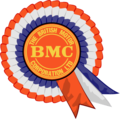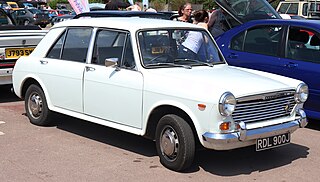
The British Motor Corporation Limited (BMC) was a UK-based vehicle manufacturer, formed in early 1952 to give effect to an agreed merger of the Morris and Austin businesses.

The Austin Motor Company Limited was an English manufacturer of motor vehicles, founded in 1905 by Herbert Austin in Longbridge. In 1952 it was merged with Morris Motors Limited in the new holding company British Motor Corporation (BMC) Limited, keeping its separate identity. The marque Austin was used until 1987 by BMC's successors British Leyland and Rover Group. The trademark is currently owned by the Chinese firm SAIC Motor, after being transferred from bankrupt subsidiary Nanjing Automotive which had acquired it with MG Rover Group in July 2005.

British Leyland was an automotive engineering and manufacturing conglomerate formed in the United Kingdom in 1968 as British Leyland Motor Corporation Ltd (BLMC), following the merger of Leyland Motors and British Motor Holdings. It was partly nationalised in 1975, when the UK government created a holding company called British Leyland, later renamed BL in 1978. It incorporated much of the British-owned motor vehicle industry, which in 1968 had a 40% share of the UK car market, with its history going back to 1895. Despite containing profitable marques such as Jaguar, Rover, and Land Rover, as well as the best-selling Mini, BLMC had a troubled history, leading to its eventual collapse in 1975 and subsequent part-nationalisation.
The Princess is a version of the Austin A99 Westminster produced by BMC from 1959 to 1968, latterly under the Vanden Plas marque.

Vanden Plas is the name of coachbuilders who produced bodies for specialist and up-market automobile manufacturers. Latterly the name became a top-end luxury model designation for cars from subsidiaries of British Leyland and the Rover Group, it was last used in 2009 to denote the top-luxury version of the Jaguar XJ (X350).

The Austin Maestro is a five-door hatchback small family car that was produced from November 1982 to 1986 by British Leyland, and from 1986 until December 1994 by Rover Group, as a replacement for the Austin Maxi and Austin Allegro, with the van version replacing the corresponding van derivative of the Morris Ital. The car was produced at Morris' former Oxford plant, also known as Cowley, with 605,000 units sold. Today, the redeveloped factory builds the BMW Mini. An MG-branded performance version was sold as the MG Maestro from 1983 until 1991.

The Austin Ambassador is a large family car that was introduced by the Austin Rover Group subsidiary of British Leyland in March 1982. The vehicle was a heavily updated version of the Princess, a saloon car that had lacked a hatchback. Only the doors and inner structure were carried over, but the wedge-shaped side profile betrayed the car's Princess origins, and it was not considered a truly new model. The Princess had been out of production for four months by the time that the Ambassador went on sale.

The Austin Montego is a British family car that was produced by British Leyland from 1984 until 1988, and then by Rover Group from 1988 until 1995. The Montego was the replacement for both the rear-wheel drive Morris Ital and the front-wheel drive Austin Ambassador ranges to give British Leyland an all-new competitor for the Ford Sierra and Vauxhall Cavalier.

The Austin-Healey 3000 is a British sports car built from 1959 until 1967. It is the best known of the "big Healey" models. The car's bodywork was made by Jensen Motors and the vehicles were assembled at BMC's MG Works in Abingdon, alongside the corporation's MG models.

The Jaguar Mark X, later renamed the Jaguar 420G, was British manufacturer Jaguar's top-of-the-range saloon car for a decade, from 1961 to 1970. The large, luxurious Mark X not only succeeded the Mark IX as the company's top saloon model, but radically broke with both its predecessor's styling and technology.

The Austin Maxi is a medium-sized, 5-door hatchback family car that was produced by Austin and later British Leyland between 1969 and 1981. It was the first British car to feature a hatchback body style.

BMC ADO17 is the model code used by the British Motor Corporation (BMC) for a range of large family cars manufactured from September 1964 to 1975. The car was initially sold under the Austin marque as the Austin 1800, then by Morris as the Morris 1800, by Wolseley as the Wolseley 18/85, and later the Austin 2200, Morris 2200 and Wolseley Six. The 1800 was voted European Car of the Year for 1965.

The BMC ADO16 is a range of small family cars built by the British Motor Corporation (BMC) and, later, British Leyland. Launched in 1962, it was Britain's best-selling car from 1963 to 1966 and from 1968 to 1971. The ADO16 was marketed under various make and model names; however, the Austin 1100 and Morris 1100 were the most prolific of all the ADO16 variants. The car's ubiquity at the height of its popularity led to it simply being known as the 1100 (eleven-hundred) in its home market. Also made with a 1300cc engine, it was then typically called 1300.

The Wolseley 6/99 and 6/110 were the final large Wolseley cars. Styled by Pininfarina with additions by BMC staff stylists, the basic vehicle was also sold under two of BMC's other marques as the Austin A99 Westminster and Vanden Plas Princess 3-Litre. Production began in 1959 and the cars were updated and renamed for 1961. The Wolseley remained in production as the Wolseley 6/110 through to 1968.

The Austin Westminster series are large saloon and estate cars that were sold by the British manufacturer Austin from 1954, replacing the A70 Hereford. The Westminster line was produced as the A90, A95, A99, A105, and A110 until 1968 when the new Austin 3-Litre took its place. Essentially badge-engineered versions of the Farina Westminsters were also produced using the premium Wolseley and Vanden Plas marques. 101,634 Westminsters were built.

The Austin 3-Litre is a British saloon car that was introduced by Austin at the London Motor Show in 1967. Codenamed ADO61, the car was intended to be BMC's offering in the 3-litre executive class and was originally designed in the early 1960s, before the British Leyland era. Unlike the visually similar front-wheel drive Morris 1800 range, the 125 bhp 3-litre engine drove the rear wheels through a conventional 4-speed gearbox.

The Austin Kimberley and Austin Tasman "X6" models are a pair of Leyland Australia-designed front-wheel-drive sedans based on the Austin 1800 (ADO17) platform, that were produced from 1970 to 1972 and sold by Austin. At the time of the X6 being launched onto the Australian market it was quite an advanced design in comparison to the other competitors from Ford, Holden and Chrysler, whose rear-wheel drive, conventionally sprung underpinnings dominated the market at the time.
Hydrosteer was the name given by George Kent Ltd and Cam Gears Limited through Hydrosteer Limited of Luton, England, to its automotive power steering system. Initially Hydrosteer manufactured the Ross-Link system for commercial vehicles from 1953 under licence from Ross Gear and Tool of U.S.A. Their own product available from 1961 was based on a cam and peg system and was characterised by its fully integrated design and variable steering ratio. This configuration provided automotive manufacturers with a fairly simple design modification to provide a power steering option for cars fitted with a conventional cam and peg steering box. It was fitted to several, mainly British, luxury automobiles of the era. Production continued up to 1973, with just over 105,000 units being produced. As a "first generation" assistance system, applications were somewhat varied in their tuning of the many system dynamics to the specific vehicle. The system fell out of use as powered rack and pinion steering systems gained in popularity.
The Austin D and K series engines are a straight-six engine made by the British Austin Motor Company between 1939 and 1968. It was developed initially for the lorry market; but was used in a number of automobiles in its later life. It was an overhead valve non-crossflow cylinder head design. Both block and head were made out of cast iron. All engines had a forged four main bearing crankshaft.






























